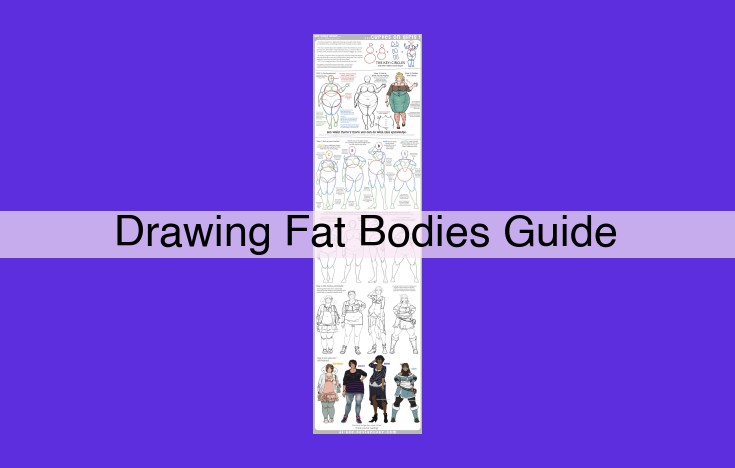- Inclusive Drawing: Embrace Body Positivity
- Proportions, Anatomy, and Body Landmarks
- Gesture and Pose: Capturing Movement and Expression
- Contour Lines: Defining Shape and Volume
- Shading and Highlights: Creating Depth and Dimension
- Line Quality: Expressing Texture and Direction
- Clothing and Accessories: Enhancing Character
- Representation: Creating Authentic Images
Inclusive Drawing: Embrace Body Positivity
In the realm of art, representation matters profoundly. When it comes to drawing, embracing body positivity and promoting diversity is crucial for creating inclusive and authentic images.
Importance of Body Positivity and Diversity
Body positivity is not just about accepting one’s own body but also acknowledging and celebrating the beauty and diversity of all body types. In drawing, it means avoiding stereotypes and distortions that perpetuate harmful beauty standards. Embracing body positivity allows artists to represent all bodies accurately and respectfully.
Focusing on Authenticity and Beauty
Inclusive drawing focuses on authenticity rather than perfection. Artists should strive to capture the unique qualities and proportions of each body type. This means avoiding exaggerating features, smoothing out curves, or concealing certain body parts. Instead, artists should embrace the natural beauty of the human form, regardless of its size or shape.
By promoting body positivity through drawing, we can challenge traditional beauty ideals and create a more inclusive and welcoming world. Let’s embrace the beauty of diversity and celebrate the power of authentic representation.
Proportions, Anatomy, and Body Landmarks
- Understanding proportions and body structure
- Familiarizing with skeletal system, muscle groups, and joints
- Importance for accurate body representation
Understanding the Human Form: Proportions, Anatomy, and Body Landmarks
In the realm of art, accurately representing the human form is paramount. It’s not merely about copying what we see; it’s about understanding the underlying structure and dynamics that give a body its unique characteristics. This is where the study of proportions, anatomy, and body landmarks come into play.
Proportions: A Guiding Framework
Understanding proportions is the cornerstone of creating realistic human figures. It refers to the size and relationship between different parts of the body. From the head to the feet, artists must master the correct ratios to achieve a balanced and harmonious form.
Anatomy: Exploring the Inner Workings
Anatomy delves into the deeper structures that support and shape the human body. Familiarity with the skeletal system, muscle groups, and joints is essential for artists who seek to depict bodies that are anatomically correct. These elements provide a framework and determine the range of motion and flexibility.
Body Landmarks: Guides to Accuracy
Body landmarks are specific points and lines on the body that serve as reference points for drawing. They help artists locate key features such as the armpits, knees, and clavicles. Understanding these landmarks ensures consistency and accuracy in representing the body’s proportions and pose.
Importance in Body Representation
The knowledge of proportions, anatomy, and body landmarks is not just about creating aesthetically pleasing drawings. It’s about fostering diversity and inclusivity in art. By understanding the spectrum of human bodies, artists can avoid perpetuating harmful stereotypes and promote a more accurate and empowering representation of all body types.
Gesture and Pose: Capturing Movement and Expression
In the realm of drawing, gesture is the key to unlocking the dynamic essence of a body in motion. It’s the subtle play of angles, curves, and lines that breathes life into figures, capturing not just their physical form but also their story.
What is Gesture?
Gesture is the shorthand language of human movement. It’s the way we convey emotions, thoughts, and intentions without uttering a single word. In drawing, it allows us to translate the subtle shifts of the body into a visual narrative that tells a tale of movement and expression.
Analyzing Angles, Curves, and Lines
The angles, curves, and lines used in gesture drawing are not arbitrary. They are carefully chosen to convey the direction and intensity of movement. For example, sharp angles suggest quick, decisive actions, while soft curves evoke a gentler, flowing motion.
By paying close attention to the relationship between these elements, we can create poses that are dynamic and expressive. For instance, a body leaning forward with arms extended suggests a sense of urgency, while a figure curled up in a fetal position conveys a vulnerability and retreat.
Enhancing Expressiveness through Gesture
Gesture is not merely about accurately depicting movement. It’s about using that movement to convey the inner workings of a character. By exaggerating certain gestures or adding subtle nuances, we can amplify the emotional impact of our drawings.
For example, a raised eyebrow can indicate surprise or skepticism, while a clenched fist suggests anger or determination. By incorporating these expressive gestures into our drawings, we bring our characters to life and make them relatable to the viewer.
Contour Lines: Defining Shape and Volume
- Role of contour lines in outlining forms
- Understanding curvature and thickness of lines
- Using contour lines to accurately portray fat bodies
Contour Lines: Defining Shape and Volume
When drawing, contour lines play a critical role in outlining the form of our subjects. The curvature and thickness of these lines significantly impact the accuracy and realism of our depictions. This is especially true when drawing fat bodies, where understanding contour lines becomes paramount.
Fat bodies possess unique shapes and curves. To capture their beauty authentically, artists must employ contour lines with care. By following the contours of the body, we can accurately portray the natural undulations and curves of fat tissue. This requires a deep understanding of the body’s structure, including its skeletal system, muscle groups, and joints.
The thickness of contour lines also conveys important information about the subject’s form. Thicker lines indicate areas of greater volume, while thinner lines suggest more delicate or recessed areas. By varying the thickness of contour lines, artists can create a sense of depth and dimension that adds realism to their drawings.
Contour lines are not merely technical tools; they are also expressive elements that can communicate the artist’s perspective. By carefully choosing the curvature and thickness of our contour lines, we can emphasize certain features, guide the viewer’s eye, and convey emotion. In the context of fat body representation, contour lines can be used to challenge stereotypes and celebrate the beauty and diversity of human bodies.
Shading and Highlights: Creating Depth and Dimension
In the realm of drawing, the interplay of light and shadow breathes life into the flat canvas. When it comes to portraying the human body, masterful use of shading and highlights brings an astonishing sense of depth and dimension to the most intimate of forms.
Unveiling the Secrets of Light and Shadow
As light caresses the human form, it sculpts and molds, casting shadows that define its curves and contours. Shadows nestle in the valleys, where anatomy conceals itself from the bright gaze. Highlights dance across the peaks, capturing the essence of roundness and convexity. By studying the dance of light and shadow, we unlock the secret to portraying bodies with authenticity and allure.
Shading: Enhancing Curves and Contours
The deft use of shading allows artists to enhance the subtle nuances of the skin, creating an illusion of three-dimensional form. By gradually transitioning from dark to light, we accentuate the curvature of hips, the slope of shoulders, and the fullness of limbs. Each shadow becomes a brushstroke, defining the contours of the body with unmatched precision.
Highlights: Bringing Forth the Essence of Form
Just as shadows define the depths, highlights illuminate the heights, bringing forth the essence of the form. They act as beacons of light, drawing attention to the most prominent features and giving the body a sense of solidity. By placing a highlight at the apex of a curve or the crest of a bone, we enhance its roundness and make it appear to rise from the page.
Depth and Realism Through Shading
The skillful application of shading and highlights adds a layer of realism that captivates the viewer. By carefully considering the way light falls upon the body, we create a sense of depth that makes the drawing seem to exist in its own space. This interplay of light and dark breathes life into the human form, transforming it from a mere sketch into a mesmerizing masterpiece.
Line Quality: Expressing Texture and Direction
In the realm of drawing, line quality emerges as an indispensable tool, granting artists the power to convey texture and direction. Embark on an artistic journey where lines become the brushstrokes that paint a tapestry of tangible surfaces and dynamic movement.
The Texture of Lines
Every line possesses a unique thickness and texture. This versatility grants artists the ability to impart a sense of roughness, smoothness, or even softness to their creations. Imagine a weathered tree bark, its textured surface effortlessly captured through bold, uneven lines. Conversely, the velvety caress of a flower petal finds expression in delicate lines, as soft and gentle as the silken touch of a butterfly’s wings.
The Flow of Lines
The direction of lines plays an equally pivotal role in artistic expression. Lines that flow harmoniously create a sense of rhythm and movement. Observe the graceful curve of a swan’s neck, beautifully depicted with lines that dance in unison. In contrast, sharp, angular lines convey a sense of tension and urgency, as if capturing the energy of a lightning bolt or the intensity of a fierce storm.
Realism Through Line Quality
The judicious use of line quality can elevate your drawings to new heights of realism. By varying the thickness, direction, and texture of lines, artists can create a palpable sense of depth and dimension. Shadows and highlights emerge, revealing the contours and nuances of the human form with lifelike accuracy. The result is an artwork that transcends the confines of mere representation, becoming a window into a world of tangible textures and dynamic movement.
Clothing and Accessories: The Fabric of Character
The attire we adorn and the accessories we carry speak volumes about who we are. In the realm of drawing, clothing and accessories play an equally pivotal role in shaping the character’s identity.
Fit and Style: The Silhouette of Expression
The fit and style of a character’s clothing can convey a myriad of messages. A tailored suit evokes professionalism, while baggy jeans suggest a more relaxed and youthful vibe. By carefully considering the proportions and silhouette of the clothing, you can create a visually striking representation of your character’s personality and background.
Texture and Detail: Unlocking Depth
The texture and detail of clothing and accessories can further enrich the character’s depiction. A soft, flowing fabric exudes femininity, while rough, rugged denim conveys a more masculine and adventurous spirit. By incorporating intricate details such as buttons, zippers, or patterns, you add depth and realism to your drawing.
Personality and Individuality: Clothing as Expression
Most importantly, clothing and accessories offer a canvas for self-expression. A character’s choices in attire reveal their personal style, interests, and aspirations. By using clothing to communicate the character’s uniqueness, you create a rich and relatable portrayal that resonates with audiences.
So, embrace the power of clothing and accessories as you delve into the world of drawing. By thoughtfully considering their fit, style, texture, and detail, you can breathe life into your characters and captivate your readers with their authentic and captivating presence.
Representation: Creating Authentic Images
The Importance of Authentic Representation
In a world that often perpetuates harmful stereotypes, authentic representation is paramount. When it comes to drawing human bodies, this means breaking free from narrow beauty standards that promote a limited view of what constitutes a healthy and beautiful body. By embracing body positivity and diversity, we can challenge these harmful tropes and promote a more inclusive and equitable representation of all body types.
Combating Stereotypes
Stereotypes, whether intentional or unconscious, can have a negative impact on our perceptions and understandings of different groups of people. In the context of drawing, avoiding harmful tropes that depict fat bodies as lazy, unhealthy, or unworthy of our attention is crucial. These tropes perpetuate negative stereotypes and reinforce harmful societal narratives.
Promoting Diversity and Realism
To promote diversity and realism in fat body representation, it is essential to draw from a wide range of references and models. This involves working with live models, studying diverse body types, and consulting with individuals with lived experiences of fatness. By doing so, we can create drawings that accurately and respectfully portray the rich diversity of human bodies.




